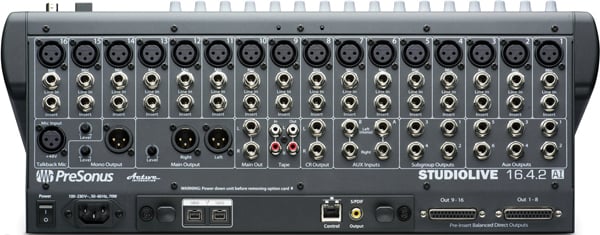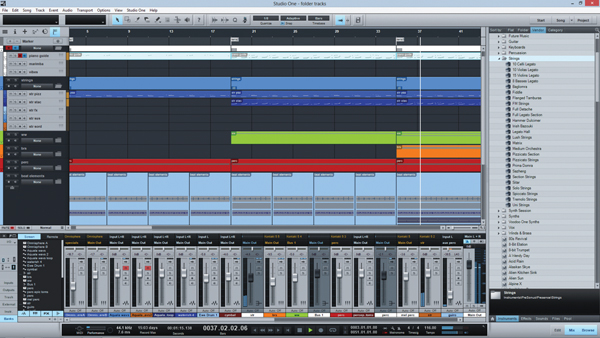An Interview with Wesley Smith, Product Manager at PreSonus
Editor’s Note: Recently PreSonus sent us one of their new 16-channel (badass) StudioLive AI Series mixers. We tried reviewing it, and ultimately couldn’t. Not because there weren’t good things to say about it, but because there was far too much to try to jam into a typical 400-word review. That’s when we hooked up with Wesley Smith, one of PreSonus’ resident gurus (otherwise known as a Product Manager, if you want to be “business-cardy” about it). She gave us the lowdown on the AI Series from conception to completion, including all the amazing tasks it can handle in just one small, affordable unit. So we begin…
Can you give us a bit of background on the development of the new StudioLive AI Series of mixers?
We started out looking to extend the legacy StudioLive line to come out with a 32-channel frame size. And while we were working on that, our recently deceased CTO [Bob Tudor] stumbled on a really cool platform, which is the active integration stuff. This allows us to do much more advanced networking. Part of the problem we were stuck with with the legacy line was that the kind of integration we wanted with our software couldn’t quite get us from where we were to where we wanted to go. Mainly because our mixers were running one platform and the software was on another. So to get that next-level integration, everything needed to be on the same framework.
The next hurdle was that our legacy StudioLives couldn’t support direct network. So if you wanted to remote control it, you had to connect them to a computer and use the computer as the network hub via Firewire to get to the legacy mixers. These were the problems we wanted to solve.

How did you go about solving these issues?
Bob found the OMAP chip, which is what we’re using now. It not only allows for a ton of processing, it’s also a Linux-based computer. So we’re now able to do direct networking. The mixers can generate their own IP addresses and pop up on the Internet and pop up on the network. We were also able to use the same framework as our software, which allows for things like integrated virtual soundcheck that we have in Capture now; so Capture [editor’s note: this a PreSonus’ simplified digital audio multi-track recording application, designed especially to work with StudioLive mixers] actually remote controls the mixer and
saves “mix scenes” with the audio sessions. And then in Studio One [editor’s note: PreSonus’ DAW] we have Fat Channel – it’s not a virtual or modeled version, it’s actually Fat Channel running on the computer. So those are the types of things we were able to do.
Can you explain some of the benefits of network integration and how you can control the board remotely, even from your iOS device?
There’s several benefits to the user. The most obvious is now being able to connect your iPad to the mixer, and that means front-of-house can be whereever you play, or wherever you need it to be. So for the gigging musician, who may have to run things from the stage, it means you can [make adjustments] on your iPad and not have to run to the mixer to make those same adjustments.
So a basic example would be the ability to have your drummer literally control the FOH mix from his seat.
Exactly, or in the case of my former band, my bass player had a wireless bass rig. And he’d go out in the audience, listen around and tell me where to make adjustments. So in this case, he could now have an iPad on a stand and make the adjustments right there [on-the-fly].
So as far as end users are concerned, who do you see this most geared towards? Touring bands or live engineers?
It’s for everybody from contracted sound companies to gigging bands. Figure a gigging band has a PA system, they have a recording system at home (because no one’s booking studio time anymore), they have to buy a DAW to record into, they have their audio interface, and then if they’re doing any sort of live mixing they’ll be running their own monitors, too. Those are all things that bands invest in – so by the time you buy a 16-channel audio interface and the mixers and PA system and monitor rig, you’re well over the cost of a StudioLive mixer.

That’s important to clarify. There may be some sticker shock from bands who perhaps don’t realize all the things this board can do and how much it would cost to buy all the components separately that they’d need. You’re not buying five or six different units and pieces of software to handle all these things.
That’s right, and there’s a lot of “me too” products out there. But they don’t provide the integrated experience that StudioLive provides. Because Studio One is designed to work with a StudioLive mixer. Capture is designed to work with a StudioLive mixer. There’s direct networking. You just scan for networks and it pops right up, or connect an Ethernet cable. It’s that easy. Even selling the shows – after you record in Capture, you open your Capture sessions in Studio One, you do your final mixes and upload directly to your Nimbit store and start selling right away.
As a musician, this really helps because you’re learning one ecosystem to handle all of your band’s sound applications. So there’s not a huge learning curve involved in figuring out how five different companies’ systems are supposed to jive together.
That’s a really good point, especially just setting up an interface to work with a DAW, which can be complicated. You have to figure out audio I/O setups and it can be a major headache. If you record in Capture it self-configures. The other thing for a gigging musician is the ability to play with backing tracks. [Editor’s note: at this point in the conversation, we go down the rabbit-hole to reminisce about our respective times spent performing industrial music in the ’90s and using DAT machines as the pinnacle of technology in our respective setups. Point being, things would have been much easier had StudioLive existed back in the day].
The cool thing with the audio interface built-in to the StudioLives, is that they’re continuously bidirectional and they’re one-to-one. Some other digital mixers with recording capabilities, you have to record things in banks of eight. Or play back things in banks of eight. So if you wanted to play back a stereo drum loop and a click track – you know, you can’t just patch three channels into the board – so that’s what’s really unique with the StudioLive workflow. If you do want to incorporate your computer into live performance, you literally press a button and that audio is streaming back to your mixer. Imogen Heap plays with the 16, that’s how she runs all her MIDI stuff.
We’ve had hands-on time here with several manufacturers’ systems, but if I’m an artist looking at different options, can you give me a quick rundown of what I’m looking at with the StudioLive AI series as opposed to say, the Mackie DL line, which also has iPad integration?
Ours has a full-featured control surface, which is one thing the DL line really doesn’t. They rely heavily on the iPad mixer, which is totally fine in a lot of circumstances. But sometimes it’s really nice to just grab a fader and have control over that. The biggest advantage that we have over the DL line is less from the iOS standpoint and more from the connectivity standpoint – specifically how many analog connections you would get. It’s got much more robust connectivity.
As far as iOS in general with the AI mixers, our goal was to make it as easy to network a mixer as it is to network your iPad. And with the iOS apps, we have a term around here called “battle ready” interfaces. We didn’t want to shove a whole mixer onto a remote app, because you already have a full tactile interface control surface to use. What we wanted to provide in SL Remote [and QMix, the wireless personal aux-mix software for iPhone/iPod Touch] were all the tools you’d need to mix remotely. So fader levels, all the Fat Channel adjustments, routing, aux mixes, graphic EQs – you already have access to those really easily. And at the same time, when you go to the iPad or iPhone, we wanted to strip down that experience to a more focused set of functions.
I’d actually like to talk about some of the fx, too. A lot of the built-in fx we’ve seen on mixing decks (especially reverbs) have a tendency to be digital and phony sounding. But the fx on the Studio Live AI boards are quite good.
With the AI mixers, without a doubt, you get the most processing of any mixer at those price points. So if we start with the Fat Channel – for every input and aux-mix (including your four internal effects mixes), you get a hi-pass filter, a full-featured gate with Key Filter, a full-featured compressor, a parametric EQ and a limiter. And then on every sub group and main bus, you get all of that except for the hi-pass filter. You just have a ton of different filters and processing. And it’s not like if you turn on one you lose another. You don’t have to make those compromises.
As far as the internal effects processors, we tried to keep it simple. We didn’t want to shove it full of choruses and flangers and tremolos, you know? Just the effects you’d use in a live situation, like reverbs and delays. Those are on the mix buses – so if you want a reverb you’re not losing an aux mix. Those buses also get Fat Channel, which I think is why people like the reverbs so much on the AIs. You can add a little compression or EQ and really dial it in.
If you do need distortion or other effects for vocals, let’s say, you have an insert point on every single channel and you if you want to use up one of you aux buses you have two stereo effects returns. So you can use those for effects returns or keyboards, if you just need some line-level inputs.
Are there any differences between the 16, 24 and 32-channel AI boards other than the number of channels?
It’s mainly the number of inputs – but the biggest difference is that the 32 has all parameters accessible from the control surface. As you go up the line, you also have more aux mixes. The 32 has 14 aux mixes, the 24 has ten auxes and the 16 has six auxes.
So bottom line, if you were talking directly to a consumer, and had 30 seconds to tell them about the AI series, what are the key features for them to remember?
I think the biggest reason to look at the AI series is that it’s not just a mixer, it’s a complete audio performance solution. We sell solutions. It’s the only mixer that allows you to do everything you need to do in a live environment, a recording environment, and to mix, master and market your material to your fanbase all in an integrated experience. We call it “riff-to-release” here.
For more info visit www.presonus.com/products/studiolive-ai-series
